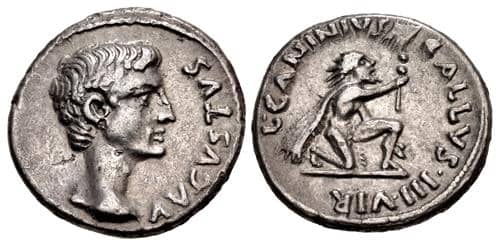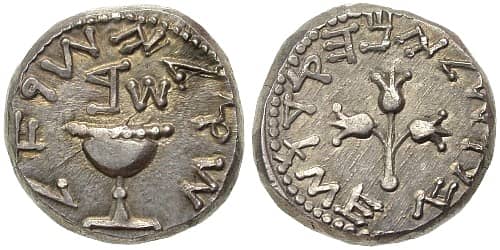Last Updated on April 14, 2025
These famous silver coins either have historic significance or are well known and popular bullion coins of the modern era. Some of them are the most beautiful silver coins in the world.
Silver has been money for thousands of years, although it has always played second fiddle to gold as a store of value.
But the fact that silver is less valuable has actually made it more useful for the vast majority of people for their everyday transactions. For that reason some of the old silver coins on this list, such as the denarius, were the dominant coin of their era.
Despite the fact that silver is no longer formally part of the modern monetary system it has not stopped behaving like a monetary metal.
Owning silver coins is still a hedge against the debasement of fiat currencies.
1. The Persian Siglos

The siglos was the silver coin of the Achaemenid (or Persian) Empire. It circulated alongside the gold daric in the world’s first bimetallic monetary system.
One gold daric was worth 20 silver sigloi.
The siglos was minted in the capital city of Sardis in modern day Turkey.
2. The Greek Drachma

Greek coinage was inspired from the developments of Lydia, who were the first to standardise metal coins with the seal of the state.
When a significant silver deposit was discovered at Laurion, near Athens, the Greeks began to develop silver coinage of their own.
As well as the drachma the Greeks also minted the didrachma, worth two drachmas, the tetradrachma, worth four drachmas and the decadrachma, worth ten drachmas.
The tetradrachm was the most common coin, with the Athenian tetradrachm being particularly famous.
3. Roman Denarius

The Roman denarius is arguably the most famous silver coin in all of history.
This was the monetary standard of the late Roman Republic and the Roman Empire.
It is also one of the most famous monetary debasements in the ancient world, if not all of history, as the silver content of the coin fell from 95% to 5% over a period of about 500 years.
4. The Shekel

Initially a unit of weight in Ancient Sumer, the shekel later became a circulating silver coin.
The Tyrian shekel became the dominant money of the Middle East around the time of Jesus Christ and it is believed that the silver coinage in the gospel were Tyrian shekels.
5. The Dirham

The dirham was the standard silver coin in the Islamic world and circulated alongside the gold dinar.
The dirham replaced the Byzantine silver coinage that circulated in regions conquered by early Islamic expansion.
There was an outflow of precious metals from Europe during the medieval period as the Islamic world experienced a golden age and much of that gold and silver found its way to the Middle East.
6. The Pound Sterling

After the fall of the Roman Empire, and with outflows of precious metals to the east, there was very limited use of silver coinage in medieval Europe.
As feudal societies were closed and self-contained, they could manage without metal coinage.
The emergence of the pound sterling signalled the re-emergence of silver as currency in Europe.
King Athelstan officially adopted the pound sterling as the official currency of England in 928.
7. The Gros Tournois

A silver standard emerged in France during the reign of Louis IX (1226-1270) who issued the gros tournois.
This coin was soon used all over Europe.
Unfortunately the gros tournois experienced significant debasement as monarchs reduced the silver content several times in order to fund military adventures. Eventually only a third of the silver content remained.
8. The Rupee

The silver rupee was first issued in 1295 by the Delhi Sultinate.
Prior to the issue of the rupee local rulers issued their own coinage.
The rupee provided a monetary standard which improved the efficiency of commerce in the region.
It also strengthened the power of the Delhi Sultinate.
The rupee continued to be the dominant currency of India during the Mughal Empire and even during the time of the British East India Company.
9. The Spanish Silver Dollar

In 1497 the Spanish monarchs Ferdinand and Isabella issued the Ordinance of Medina del Campo.
This was a significant monetary reform which made the real de a ocho, also known as pieces of eight or the Spanish silver dollar, into the monetary standard.
This period was a shift in power away from the Italian city states and the monetary dominance of the Florin, towards the emerging power of Spain.
10. The Silver Thaler

In 1600 an enourmous silver deposit was discovered in a town called Joachimsthal near the German/Czech border.
Silver coins minted in the area became known as Joachimsthalers. The short name became thaler.
In English, this name translates into “dollar” and is where we get the name.
11. The Flowing Hair Dollar

The United States Coinage Act of 1792 established the silver dollar as the monetary standard of the nation and authorised the minting of coins.
However, it was not until 1794 that the first silver coins were struck.
The Flowing Hair Dollar was the first official silver coin in the United States and were struck in 1794 and 1795 in Philadelphia.
12. Morgan Silver Dollars

Morgan silver dollars are one of the most famous silver coins in the United States.
They were minted between 1878 and 1904 and are named after United States Mint Engraver George T. Morgan.
Morgan silver dollars are historically significant because they began to be struck after the Bland Allison Act was passed in 1878.
The free coinage of silver had been ended in 1873 in what was known as the crime of 1873. This kicked off a fierce political debate in the United States regarding the merits of the gold standard versus bimetallism.
The 1878 Bland Allison Act restored the legal tender status of silver and required the US Treasury to purchase between $2 million and $4 million of silver per month. This is when the Morgan silver dollar began to be issued.
The Morgan silver dollar is also famous for its association with the old Wild West and is a very popular collectible coin.
13. The Canadian Silver Maple

The Royal Canadian Mint first minted the silver maple in 1988, after the huge success of the gold maple.
The silver maple is now one of the most popular bullion coins in the world.
Its point of difference is that it is 99.99% pure silver, compared to most other bullion coins which are 99.9% pure.
14. The American Silver Eagle

American silver eagles are another immensely popular modern bullion coin.
They were first struck in 1986 as a means for the United States to sell down its stockpile of silver.
The obverse design on the modern silver eagle comes from the famous 1916-1947 coin, the Walking Liberty Half Dollar, popularly considered as one of the most beautiful American coins.
With the stockpile of silver now exhausted, the United States Treasury buys silver on the open market to mint into silver eagles.
Conclusion
Silver has always been the money of the people.
It has often formed part of a monetary system alongside gold but is a monetary metal in its own right.
These coins are famous for their historical significance and are popular among collectors and numismatists.
Image Credits
Famous Silver Coins by Zlataky on Unsplash
Persian Siglos is licensed under CC-BY-SA 2.5
Greek Drachma is in the public domain
Roman Denarius is in the public domain
Silver Shekel of the First Jewish Revolt is in the public domain
Dirham is in the public domain
Pound Sterling is licensed under CC-BY-SA 2.0
Gros Tournois is licensed under CC-BY-SA 3.0
Rupee is in the public domain
Spanish Silver Dollar is licensed under CC-BY-SA 4.0
Silver Thaler is licensed under CC-BY-SA 4.0
Flowing Hair Dollar is in the public domain
Morgan Silver Dollar is in the public domain
Canadian Silver Maple by Dave McDermott on Unsplash
American Silver Eagle is in the public domain



